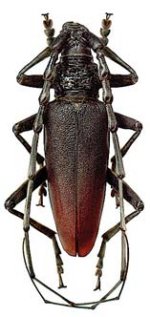Common menu bar links
Cerambyx cerdo (Linnaeus) - Great Capricorn beetle
Coleoptera: Cerambycidae
IDENTIFICATION
Adult beetles are 24 to 53 mm long, with a blackish body and legs.25 Male antennae are twice as long as the body, while those of the female extend to the elytral apex.25 The pronotum is roughly textured and greater in width than in length. The tapered elytra are reddish-brown towards the apex.25 The elytral apex has well developed sutural spines.128
HOST TREES
Quercus (main host), Carpinus, Castanea, Ceratonia, Fagus, Fraxinus, Juglans, Pyrus, Robinia, Salix and Ulmus.25, 85, 128
LOCATION OF INFESTATION WITHIN THE TREE
Larvae feed on the inner bark, sapwood and heartwood along the stem.25, 128
HOST CONDITION
Mature, weakened (e.g. diseased, pruned) trees, especially those growing in open and sunny locations.25, 85, 117, 128 Occasionally young or healthy trees are attacked.85
DISTRIBUTION
Europe, Asia, Caucasus, Asia Minor and northern Africa.25, 121, 128
SIGNS AND SYMPTOMS
Females lay eggs in the bark.117 Larvae develop in the inner bark before penetrating into the sapwood, and then into the heartwood.25, 117, 128 Larval galleries are long, irregular and widen as the larvae increase in size.25, 117, 128 Larval development may take up to 2 to 5 years.25, 117
Pupation occurs in the sapwood (approximately 80 mm deep) in a large, elongate, oval pupal cell that is partitioned from the larval gallery by a calcareous operculum secreted by the larvae.128 Adults overwinter in the pupal cell and emerge at the end of spring, during the summer, or at the beginning of fall.25, 117 Exit holes are more or less oval and up to 2 cm in diameter. Brown frass also accumulates at the base of infested trees.
Dark resin seeps from holes at attack sites.117 Several generations may develop in the trunk. Re-infestation may continue year after year, highly degrading the wood and in some cases causing death of the infested tree.117, 128

A - Male C. cerdo (24-53 mm long). Antennae are twice the body length.

B - Female C. cerdo (24-53 mm long).Antennae extend to the elytral apex.

C - Elongate and oval C. cerdo pupal chamber.

D - Adult C. cerdo. Elytra are reddish-brown towards the apex.

E - C. cerdo larval galleries within the sapwood.

F - Long, irregular-shaped C. cerdo larval galleries in the inner bark.
Galleries widen as the larvae increase in size.
Photo credits
- A Zoological Institute, Russian Academy of Sciences
- B Zoological Institute, Russian Academy of Sciences
- C Gyorgy Csoka, Hungary Forest Research Institute, Image 1231104, forestryimages.org, Feb. 4, 2003
- D Gyorgy Csoka, Hungary Forest Research Institute, Image 1231106, forestryimages.org, Feb. 4, 2003
- E Karl-Heinz Apel, Landesforstanstalt Eberswalde, Abteilung Waldschutz
- F Gyorgy Csoka, Hungary Forest Research Institute, Image 1231105, forestryimages.org, Feb. 4, 2003
